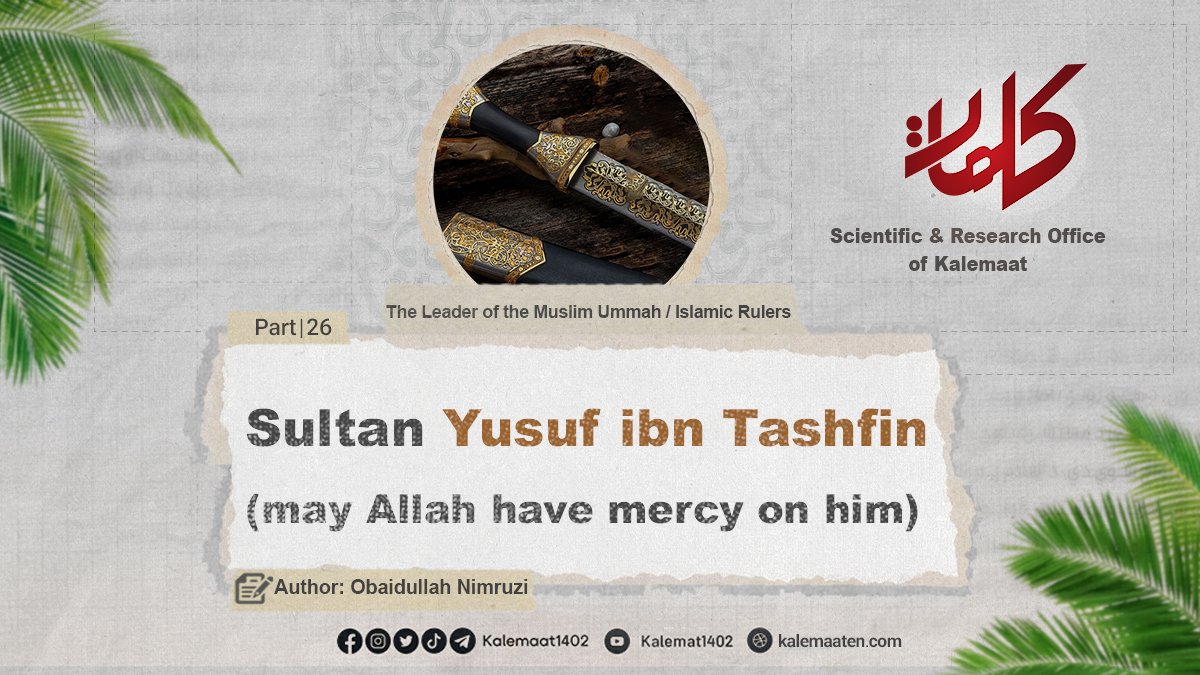
Author: Ubaidullah Nimruzi
The Guardian of al-Andalus (Spain); Sultan Yusuf ibn Tashfin [MABH] (Part 26)
Expansion of the Almoravids’ territory; Conquering new areas and reforming affairs
After conquering the Mahdi fortress, Yusuf went to the areas of Banu Marasin and Bilad Warghah, and these areas joined the Almoravid territory. They suppressed the resistance and established justice and law in these areas. [1]
Historical disagreement in recording events; but consensus on the general trend of the Almoravids’ progress
Despite the strong disagreement among historians about the exact date of events, everyone agrees that the Almoravids were able to gradually consolidate their rule in the north of the Maghreb. These disagreements arose due to reasons such as the late recording of events and the destruction of monuments by the Almohads. [2]
The annexation of Bilad Ghamrah and the Rif Mountains to the Almoravids
In 460 AH, Bilad Ghamara and the Rif Mountains joined the city of Tangier and came under Almoravid rule. [3]
Almoravid conquests and the first step in reforming the city of Fez
Although there is no disagreement among historians about the entry of the Almoravids into the city of Fez in 455 AH; But there is disagreement about their complete and final control over the city. Ibn Abi Zarh believes that the Almoravids entered Fez in 462 AH, after a severe siege; the city was then divided into two parts: Udwat al-Qarawiyyin and Udwat al-Andalus. Yusuf ibn Tashfin ordered the demolition of the walls separating these two parts and transformed Fez into a single city. He fortified the city, began construction in it, and ordered the construction of mosques on the outskirts, alleys, and streets; even there was no mosque in a neighborhood, he would take the residents there and oblige them to build a mosque.
He also ordered the construction of baths, guesthouses, and public spaces, and the repair of the markets. He also organized the buildings of the city. By these measures, Yusuf ibn Tashfin brought about comprehensive reforms in the urban structure of Fez and gave it a new face; a face worthy of an Almoravid city. Undoubtedly, these reforms reflected his high taste for civilization and his clear and forward-looking outlook on life, as well as his deep understanding of what Islamic cities should be like.
Mosque; the beating heart of Islamic society
It should be known that building a mosque also means building a school and a center of knowledge. The mosque is a place of study and worship; a place where divine commands are implemented and from where armies are dispatched for jihad in the way of Allah. The mosque pulpit is a base for calling to jihad and announcing news of victories. Therefore, any alley that was deprived of a mosque was worthy of punishment, because no valid excuse for such a deficiency was accepted.
Yusuf ibn Tashfin resided in Fez until 463 AH and personally supervised the implementation of the reforms. After he was assured of the establishment of peace and the success of his measures in this very important city, he set out for the Malwia regions in the same year and captured the forts of Watat, adding them to the Almoravid territory. [4]
Yusuf ibn Tashfin’s inspection and advisory trip to the entire Maghreb
After these great conquests that led to the expansion of the Almoravid territory, the expansion of the borders, and the increase in the number of subjects, Yusuf ibn Tashfin felt that it was necessary to take a general and comprehensive look at the situation of his fledgling state in order to properly assess the tasks of leadership and the resources at his disposal.
In this regard, in 464 AH, he invited all the princes and elders of the Maghreb tribes, including the Zanata, Ghomara, Mosamedah, and other tribes subject to the Almoravids. [5] His invitation was met with universal acceptance. At this gathering, Yusuf ibn Tashfin explained to them the dangers of discord and the terrible consequences of division. He emphasized the common responsibility of all before Allah, and said that the only way to escape division and trouble is through sympathy and obedience to the Islamic law; a law that gives every right holder his right and whose laws bring peace to the hearts and satisfaction of the believing nations.
General allegiance and a new covenant with the leadership of the Almoravids
After this passionate meeting of faith and consultation, everyone declared their allegiance with their hearts and souls to Yusuf ibn Tashfin as the emir and commander of the jihad caravan. He also accepted their allegiance and promised to continue the path of jihad; then, he attended to their needs and sent everyone back with satisfaction with dignity; but his work was not limited to consulting with the representatives of the tribes; rather, he personally traveled with them to different regions of the Maghreb and closely examined the situation of the people, inspected the work of the governors and solved many of the people’s problems. [6]
Continues…
References:
- Al-Salawi, Al-Istiqsā, Vol. 2, p. 50.
- Al-Qurtubi, Al-Badr Al-Tali’, Vol. 1, p. 102.
- Ibn Al-Khatib, A’mal Al-A’lam, Vol. 3, p. 240.
- Ibn Abi Zarh, Rawzat Al-Qirtas, p. 91; Ibn Azari, Al-Bayan Al-Maghrib, Vol. 4, p. 28; Al-‘Ilal Al-Mawshiyya, p. 28; Al-Ilal Al-Mawshiyya, Vol. 2, p. 29.
- Ibn Abi Zarh, Rawzat Al-Qirtas, p. 91.
- Ibid.



